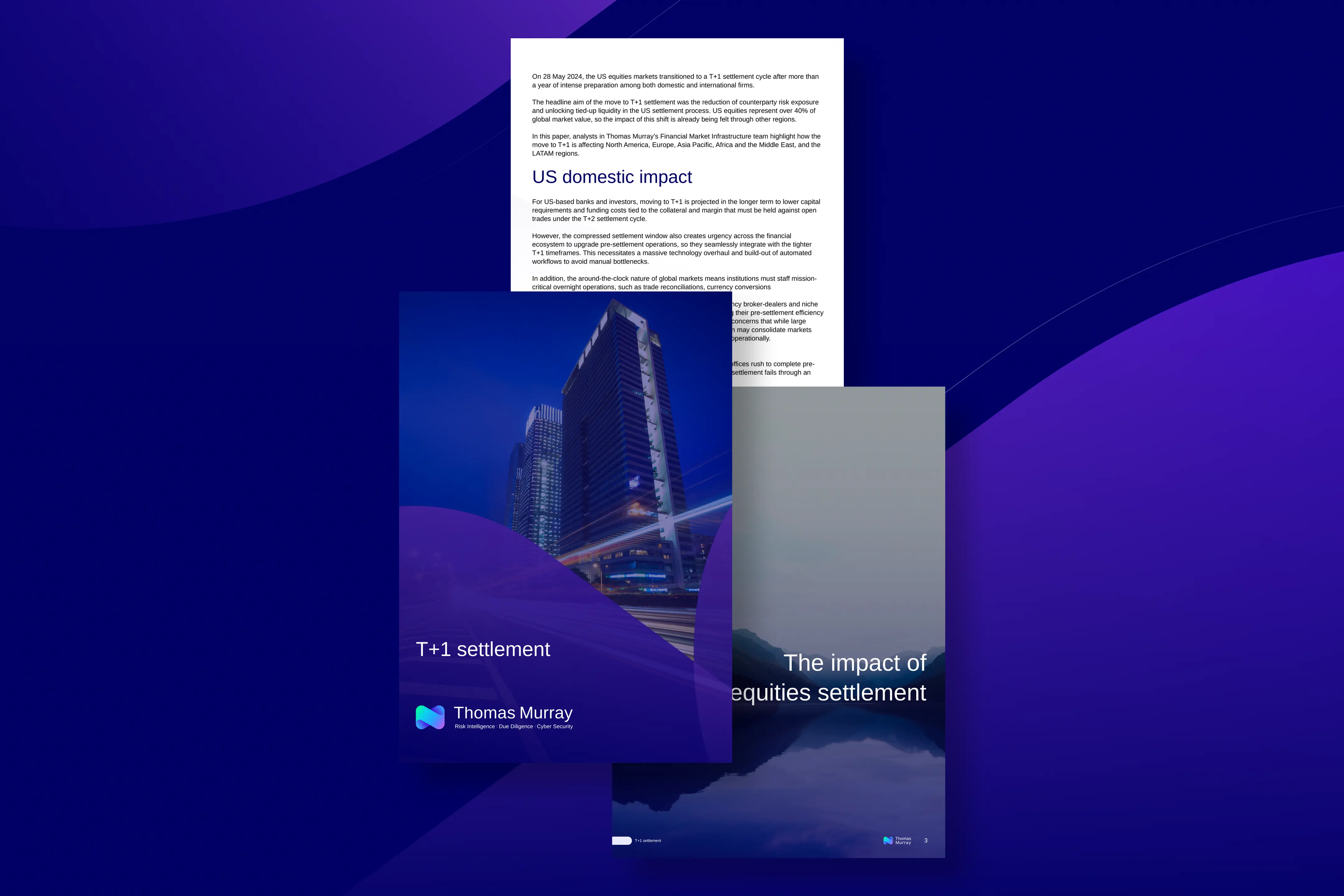The Securities and Exchange Commission (SEC) named 28 May 2024 as the transition date for the move to a T+1 settlement cycle in the US equities markets.
The move to T+1 settlement has the headline aims of reducing counterparty risk exposure and unlocking tied-up liquidity in the US settlement process. US equities represent over 40% of global market value, so the impact of this shift is already being felt through other regions.
This is the first in a series of updates that will highlight how T+1 is affecting Europe, Asia Pacific, Africa and the Middle East, and the LATAM regions. In this first instalment, Jim Micklethwaite, Panagiotis Kiziris and Reuben Gifford give an overview of the domestic and international impacts, the effect on the foreign exchange markets and what the future may hold.



On 28 May 2024, the US equities markets transitioned to a T+1 settlement cycle after more than a year of intense preparation among both domestic and international firms.
The headline aim of the move to T+1 settlement was the reduction of counterparty risk exposure and unlocking tied-up liquidity in the US settlement process. US equities represent over 40% of global market value, so the impact of this shift is already being felt through other regions.
US domestic impact
For US-based banks and investors, moving to T+1 is projected to lower capital requirements and funding costs tied to the collateral and margin that must be held against open trades under the T+2 settlement cycle.
However, the compressed settlement window also creates urgency across the financial ecosystem to upgrade pre-settlement operations, so they seamlessly integrate with the tighter T+1 timeframes. This necessitates a massive technology overhaul and build-out of automated workflows to avoid manual bottlenecks.
In addition, the around-the-clock nature of global markets means institutions must staff mission-critical overnight operations, such as trade reconciliations, currency conversions, payment processing, and custodial transactions, to handle time-zone friction.
With limited resources, it has been the smaller regional banks, agency broker-dealers and niche firms that have faced the biggest challenges in improving their pre-settlement efficiency before the May 2024 go-live date. Industry committees had voiced concerns that while large banks could afford to take on the upgrade costs, forced acceleration may consolidate markets further and put pressure on smaller players that cannot keep pace operationally.
Ultimately, this will also put pressure on operational risks, as back offices rush to complete pre-settlement on a compressed timescale. This could in turn increase settlement fails through an inability to meet deadlines for matching and funding.
Despite some teething problems at both CDS in Canada and DTC in the US on their respective first settlement days, the move was considered a success by the industry and market players seemed to have been sufficiently prepared. DTC reported higher rates of affirmation than average in the first few days after migration, while fail rates are slightly lower than average under T+2. The NSCC Clearing Fund contributions reduced by 25% from the previous month, suggesting some of the gains in liquidity promised are already starting to be realised.
Nevertheless, it is still early days after the migration, and only time will tell whether these efficiencies will persist.
International impacts
Internationally, overseas banks conducting equity transactions in US markets must maintain highly efficient cross-border funding processes to enable timely currency conversions aligned with T+1 settlement. This necessitates additional liquidity and cash buffer pools to prefund US trades a full day ahead of local settlement finality. Either prefunding or additional credit lines will have a capital impact, which could be passed on to cross-border investors in the form of increased fees.
Reconciling home market T+2 settlement norms against T+1 US assets (particularly for dual-listed issues) also introduces added complexities around synchronising posting, transaction tracing and nostro account structures across mismatched cycles. Several CSDs have announced special provisions around dual-listed securities to account for the effect of cycle mismatches.
This asymmetry could reshape relative incentives and spur shifts in global trading relationships as regulatory arbitrage opportunities realign. Institutions may face incentives to route flows toward earlier settling centres.
For emerging markets already struggling with dollar liquidity shortages, such dynamics may strain local swaps markets and currency rate stability. Frontier countries still developing their capital markets face rising transition costs, and risk isolation as global infrastructures upgrade without waiting for laggards.
The FX market
The main issue facing foreign investors trading in US securities will be to synchronise equity and FX settlement. Foreign investors need to execute an FX trade to fund the purchase or sale of US securities in US dollars from their local currencies. A major complication is that different currencies have different cut-off times, which are usually dictated by the domestic real-time gross settlement (RTGS). Additionally, cash correspondent banks will have their own deadlines for accepting instructions. Investors would need to fine-tune their processes to be able to fund their trades in US dollars in time for T+1 settlement.
The FX market is already capable of settling T+1 but there is very little incentive for radical operational changes to accommodate US securities trades, which account for a small part of the global FX market. CLS, the global multicurrency settlement system, has decided not to make any changes to its cut-off times to accommodate the new US timelines. This means that foreign investors would either have to move certain transactions away from CLS, which would increase their settlement risk, or they would have to fund their trades as early as the end of trade date. FX trades are usually booked after matching confirmation and the short window may reduce netting abilities, increasing FX liquidity pressures.
Paradoxically then, by accelerating the US equities settlement cycle, the associated FX trade lifecycle compresses dramatically, and investors may end up taking on additional cross-border settlement risk and negatively impacting FX liquidity. This rush to meet deadlines will most likely result in increased fails and higher cross-border settlement fees.
The future
Pre-settlement and settlement activities in the US and other markets are still very much performed on systems and workflows that require considerable manual intervention. Deceasing manual operations to increase efficiency is obviously a laudable end goal. However, smaller market players, with fewer resources and a smaller geographical footprint, may struggle to adapt their systems and workflows for a move to T+1, while larger banks will push for costly adjustments that could bring client fees up.
Nevertheless, in certain parts of the industry, advances in technology are developing that could lead to even faster settlement: distributed ledger technologies that could enable atomic settlement; machine learning and artificial intelligence that could alleviate pre-settlement manual processes; and central bank digital currencies that could support instantaneous transactions in different currencies.
The Bank for International Settlement (BIS) has launched Project Agorá, which is bringing together seven central banks to explore how tokenised commercial bank deposits can be seamlessly integrated with tokenised wholesale central bank money in a public-private programmable core financial platform:
- Bank of France (representing the Eurosystem);
- Bank of Japan;
- Bank of Korea;
- Bank of Mexico;
- Swiss National Bank;
- Bank of England; and
- the Federal Reserve Bank of New York.
Bringing all these technologies together in a methodical and coordinated manner could accelerate the next move to an even shorter cycle (T+0) as is planned in India in 2024.
Last updated 10 June 2024.
More on T+1
T+1 settlement cycles: Lessons from India and the Asia Pacific
Slow and steady: The EU and UK approach to T+1 settlement cycles
T+1 settlement eBook
In this paper, analysts in Thomas Murray's Financial Market Infrastructure team highlight how the move to T+1 is affecting North America, Europe, Asia Pacific, Africa and the Middle East, and the LATAM regions.


Thomas Murray's Risk Committee
Thomas Murray's Risk Committee is made up of analysts, experts in financial market infrastructures (FMIs) and network managers. The committee meets regularly to assess the health and stability of capital markets, custodian banks, transfer agents, fund platforms, prime brokers, cash correspondents and market infrastructures around the world.
Insights

NYSE proposes around-the-clock trading
The New York Stock Exchange exploring the possibility of trading on a 24/7 basis has caused both excitement and concern among market participants.

Cash correspondent banking and monitoring: A primer
Correspondent banking, whether traditional or digital, plays a vital role in the international financial system.

Correspondent monitoring: A safeguard against the worst-case scenario
Correspondent banking plays a vital role in the global financial system, though it does carry significant risks.

Liquidity in Ghana and Zambia
The state of foreign exchange liquidity across Africa often shares several key features and challenges that impact the region’s financial markets.


